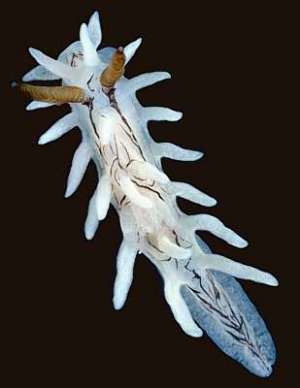
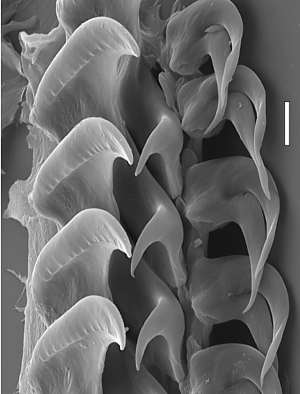
Okenia vena
Rudman, 2004
Order: NUDIBRANCHIA
Suborder: DORIDINA
Superfamily: ANADORIDOIDEA
Family: Goniodorididae
DISTRIBUTION
Known only from northern New South Wales, eastern Australia.
PHOTO
Upper Right: Pig Is, Coffs Harbour, New South Wales, Australia, December 1990, 9 mm long, AM C164620. Photo: Bill Rudman. Lower Right: Section of right side of radular ribbon. Note large pointed secondary spine on the outer corner of the inner teeth and large bicuspid outer teeth. Pig Is., Coffs Harbour, New South Wales, Australia, 8 December 1990, AM C164606. Scale bar = 10 µm. Photo: A.C. Miller.
The body is elongate, with a distinct mantle edge bearing 7- 8 cerata-like papillae on each side, all of similar length, approximately the width of the mantle. There is a single mediodorsal papilla about midway between the head and the gills, and a group of 3 or 4 papillae arranged in a transverse line just in front of the gills. There is also a single papilla in the mid-line, just behind the gills, but sometimes there can be a pair. There are up to 7 gills arranged in an arch around the anal papilla in the postero-dorsal midline. The head has a pair of broad, flattened oral tentacles. This species grows to at least 10mm long alive. The whole of the body is a translucent white, with an irregular pattern of dark brown lines arranged in a longitudinal and diagonal network on the dorsum and the sides of the body. In some specimens there can be some brown 'smudging' on the papillae, and in others, the translucent white gills can have the inner edge of the rachis lined with brown. The rhinophores are orange-brown
The radula is fairly typical of the Goniodorididae The innermost tooth has a broad base and a long elongate pointed cusp and has only faint indications of denticulation. There is a large pointed spine on the dorso-lateral corner of the base of the tooth. The much smaller outer teeth have two very large, slightly recurved, pointed cusps
This species has a very distinctive colour pattern. It has been found with Okenia purpurata, which is similar in external shape, on the same bryozoan colony, but the colour pattern of the two species is quite different with Okenia purpurata having a purple body and white papillae. Okenia purpureolineata Gosliner, 2004 has similarities in shape and colour, but in that species the network of lines on the dorsum are purple, the background colour and the papillae are purplish, there is a different arrangement of dorsal papillae, and the shape of the radular teeth are quite different, with prominent denticles on the innermost teeth and no distinct cusps on the outer teeth. It is found on the ctenostome bryozoan Amathia tortuosa Tenison Woods, 1880.
-
Rudman, W.B. (2004) Further species of the opisthobranch genus Okenia (Nudibranchia: Goniodorididae) from the Indo-West Pacific. Zootaxa, 695: 1-70.
Rudman, W.B., 2004 (December 21) Okenia vena Rudman, 2004. [In] Sea Slug Forum. Australian Museum, Sydney. Available from http://www.seaslugforum.net/find/okenvena
Related messages
Okenia purpurata & Okenia vena together
January 25, 2007
From: Leanne & David Atkinson
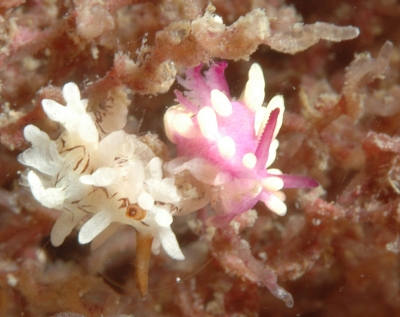
Hi Bill,
Okenia purpurata and Okenia vena are still at Halifax Sponge Gardens. Here are some photos of Okenia purpurata and Okenia vena 'pairs' in the Amathia tortuosa. Not sure what they were doing other than competing perhaps for the same piece of food.
Locality: Halifax Sponge Gardens, Marine Reserve, Port Stephens, 13 metres, New South Wales, Australia, Pacific, 21 January 2007, Sandy bottom with scattered sponges, soft corals, ascidians, bryozoans and hydroids.. Length: approximately 2 to 3 mm. Photographer: Leanne & David Atkinson.
Regards,
Leanne & David Atkinson
atk@hunterlink.net.au
Atkinson, L. & D., 2007 (Jan 25) Okenia purpurata & Okenia vena together. [Message in] Sea Slug Forum. Australian Museum, Sydney. Available from http://www.seaslugforum.net/find/19300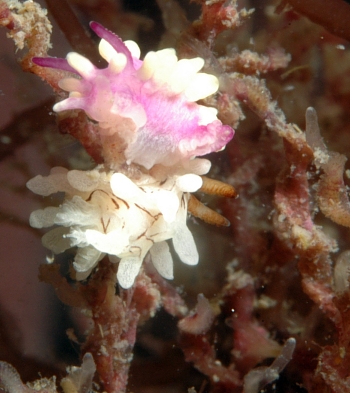
Dear Leanne & David,
Finding two different species together like this does raise interesting questions. There is no sign of matng. It is possible that they have eaten most of the zooids in the bryozoan colony and are fighting over the last scraps, but it may be that they are following each mucus trails. I suspect that the chemical difference in the mucus of closely related species is not that great, so it could be a common mistake for them to follow each others trail. This would be a mistake if they had mating in mind, but it would also be a useful way to find food - since they both feed on the same bryozoan.
Best wishes,
Bill Rudman
Okenia vena mating
January 17, 2007
From: Leanne & David Atkinson
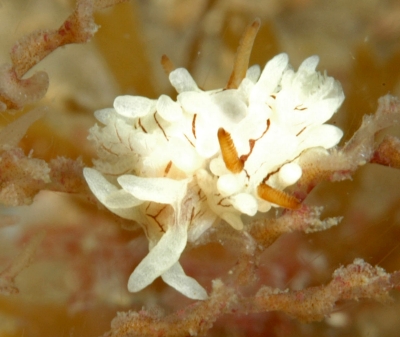
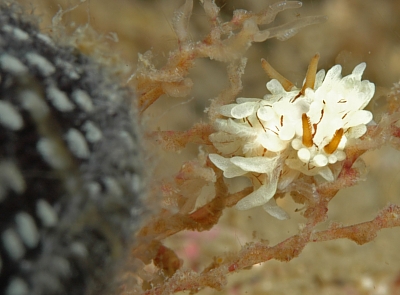
Dear Bill,
We were thrilled to find both Okenia vena and Okenia purpurata again at Port Stephens yesterday. Here are some photos of Okenia vena that we discovered were mating when we looked at the photo on the computer after the dive. Since they're mating we'd assume they are adults? These were relatively small in comparison to Leanne's black-gloved finger in the 2nd photo and she only wears a small glove. We found them on their food bryozoan again looking to the naked eye like tiny flecks of broken shell.
Locality: Halifax Sponge Gardens, Marine Reserve, Port Stephens, 16 metres, New South Wales, Australia, Pacific, 13 January 2007, Sandy bottom with scattered sponges, ascidians, soft corals, and bryozoans. Length: approximately 2 to 3 mm. Photographer: Leanne & David Atkinson.
We have more photos of Okenia purpurata but they weren't doing anything exciting and we weren't sure whether to send them since you have our previous message from the same area. By the way we found it is linked to the fact sheet for Okenia purpureolineata instead of Okenia purpurata.
Regards,
Leanne & David Atkinson
atk@hunterlink.net.au
Atkinson, L. & D., 2007 (Jan 17) Okenia vena mating. [Message in] Sea Slug Forum. Australian Museum, Sydney. Available from http://www.seaslugforum.net/find/19228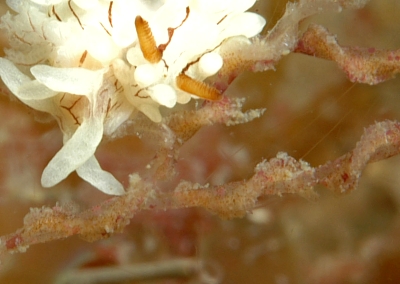
Dear Leanne & David,
Photos of any species we know so little about are welcome. I would certainly like some more of O. purpurata. Even getting another record of both these species occurring on the same bryozoan Amathia tortuosa is valuable, because it is the way we gradually build up our knowledge of just how specialised these species are in the food they eat. It also gives us a better idea of just how variable the colour pattern is in each species.
I have included a close-up alongside from one of your photos which shows how the row of zooids forms a spiral up the stalk of the bryozoan colony. I presume that is how this species got the name tortuosa [= twisted]. Sorry about linking your earlier message to the wrong species - I've fixed it. I try to weed out errors like this but am always grateful for any proof-reading help.
Best wishes,
Bill Rudman
Okenia vena from Port Stephens, NSW
February 22, 2006
From: L. & D. Atkinson
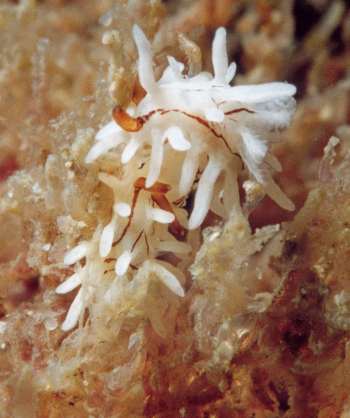
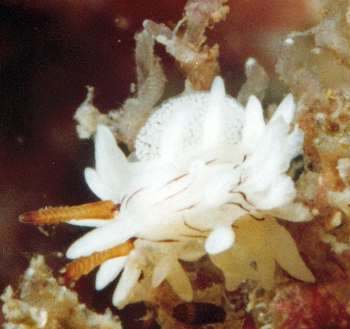
Dear Bill,
A blackout interrupted us sending this at the same time as the Okenia purpurata message [#15897]. As you mentioned on the fact sheet we also found Okenia vena in the same Amathia tortuosa as the Okenia purpurata, over the same time period of the summer of 2000. We have not seen them again but keep looking in the hope they will turn up again, when the currents etc. are right. One of these appeared to be laying a white egg ring. Hope this is of interest.
Thanks as always for your wonderful work on the Sea Slug Forum. We have learnt a great deal since it started. Understanding these creatures has helped us find more nudibranchs and allowed us in turn to contribute information.
Locality: The Wall, Halifax Sponge Gardens, Marine Reserve Port Stephens, 10 metres, New South Wales, Australia, Pacific Ocean, 29 December 2000, Sand and rock wall covered in sponges, ascidians, hydroids and bryozoans. Length: 3 mm. Photographer: Leanne & David Atkinson.
Regards,
Leanne & David Atkinson
atk@hunterlink.net.au
Atkinson, L. & D., 2006 (Feb 22) Okenia vena from Port Stephens, NSW. [Message in] Sea Slug Forum. Australian Museum, Sydney. Available from http://www.seaslugforum.net/find/15907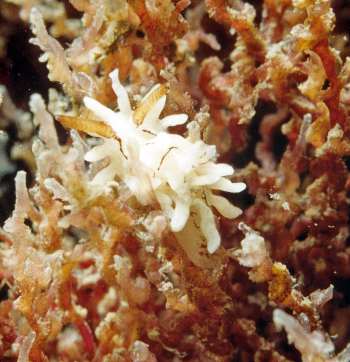
Dear Leanne & David,
When you sent the Okenia purpurata message I wondered if O. vena was also there. They are not always found together, but they are both attracted to the same bryozoan. I'm glad you enjoy the Forum. Your contributions are providing us with much new information on this fascinating group of animals.
Best wishes,
Bill Rudman
